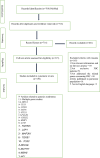Understanding genetic variations associated with familial breast cancer
- PMID: 39390525
- PMCID: PMC11465949
- DOI: 10.1186/s12957-024-03553-9
Understanding genetic variations associated with familial breast cancer
Abstract
Background: Breast cancer is the most frequent cancer among women. Genetics are the main risk factor for breast cancer. Statistics show that 15-25% of breast cancers are inherited among those with cancer-prone relatives. BRCA1, BRCA2, TP53, CDH1, PTEN, and STK11 are the most frequent genes for familial breast cancer, which occurs 80% of the time. In rare situations, moderate-penetrance gene mutations such CHEK2, BRIP1, ATM, and PALB2 contribute 2-3%.
Methods: A search of the PubMed database was carried out spanning from 2005 to July 2024, yielding a total of 768 articles that delve into the realm of familial breast cancer, concerning genes and genetic syndromes. After exclusion 150 articles were included in the final review.
Results: We report on a set of 20 familial breast cancer -associated genes into high, moderate, and low penetrance levels. Additionally, 10 genetic disorders were found to be linked with familial breast cancer.
Conclusion: Familial breast cancer has been linked to several genetic diseases and mutations, according to studies. Screening for genetic disorders is recommended by National Comprehensive Cancer Network recommendations. Evaluation of breast cancer candidate variations and risk loci may improve individual risk assessment. Only high- and moderate-risk gene variations have clinical guidelines, whereas low-risk gene variants require additional investigation. With increasing use of NGS technology, more linkage with rare genes is being discovered.
Keywords: ATM; BRCA; TOX3; Breast cancer; Familial breast cancer.
© 2024. The Author(s).
Conflict of interest statement
The authors declare no competing interests.
Figures



References
-
- 20-breast-fact-sheet.pdf.
-
- Vaghari-Tabari M, et al. Signaling, metabolism, and cancer: an important relationship for therapeutic intervention. J Cell Physiol. 2021;236:5512–32. - PubMed
-
- Wendt C, Margolin S. Identifying breast cancer susceptibility genes – a review of the genetic background in familial breast cancer. Acta Oncol. 2019;58:135–46. - PubMed
Publication types
MeSH terms
Supplementary concepts
LinkOut - more resources
Full Text Sources
Medical
Research Materials
Miscellaneous

